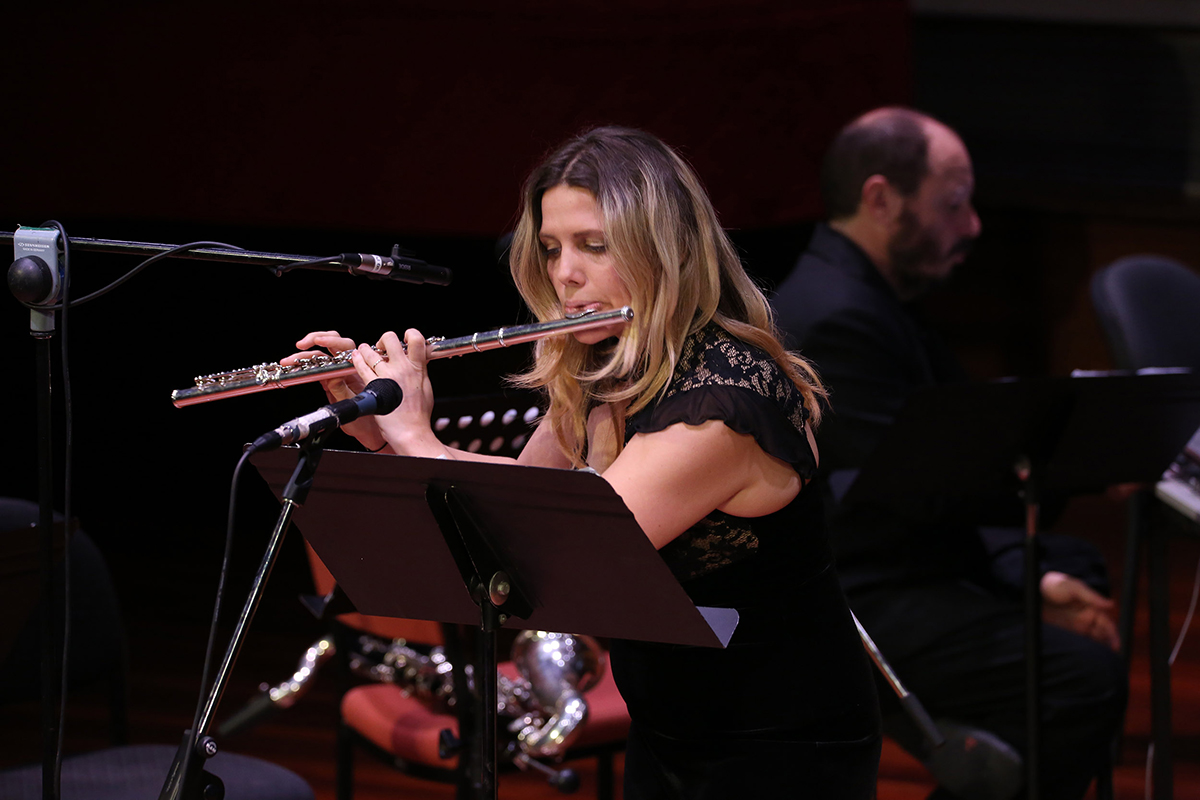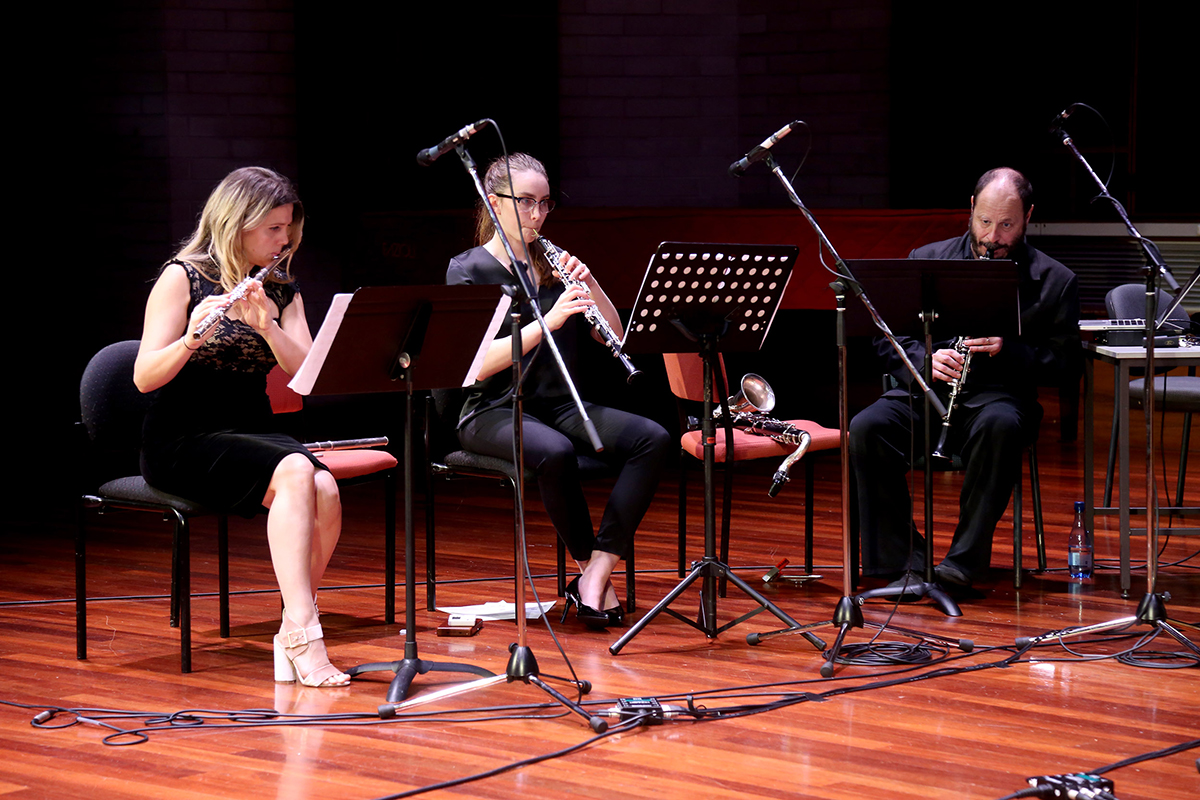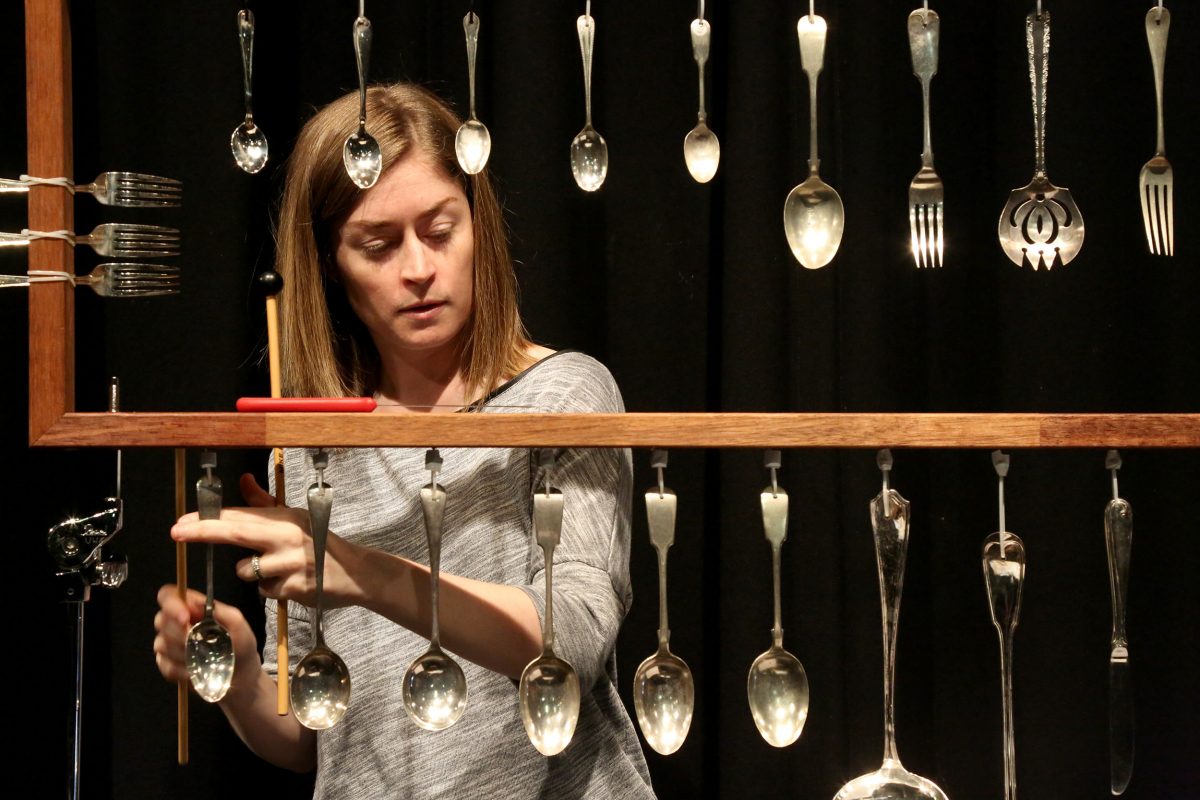Composer and performer (and, declaration, fellow staff member) Lindsay Vickery’s latest project is GreyWing, an ensemble founded last year with a core membership of himself on saxophone, clarinet and electronics, Catherine Ashley on harp and Jameson Feakes on guitar. In Tura New Music’s Scale Variable series, Vickery’s program for a concert titled Rio 1917 drew on artists from his local and international connections and his role as Coordinator of Composition and Music Technology at the Western Australian Academy of Performing Arts. Performers and composers included WAAPA staff members (composer Pedro Alvarez, guest keyboardist Stewart Smith), former students (GreyWing members Ashley and Feakes and guest flautist Kirsten Smith) and WAAPA-trained composers Sam Gillies, Alexander Turley, Ellie Cumming and Eduardo Cossio.
Vickery’s starting point for his programming was the visit to Brazil by French composer Darius Milhaud in 1917 where he worked with that country’s greatest composer, Heitor Villa-Lobos. The latter’s lovely Modernist pastoral, Sexteto Mistico, opens the concert. New works by Gillies, Turley, Cumming and Vickery use details of Villa-Lobos’ piece as the inspiration for new works (although the musical similarities are indirect), and further South American influence is presented in compositions by Chilean expatriate Alvarez, Peruvian expatriate Cossio and Brazilian Felipe Lara.

Kirsten Smith, Rio 1917, WAAPA, photo Bohdan Warchomij courtesy TURA New Music
Given the central place of musical Modernism, Surrealism and Impressionism in the programming, this is definitely not a Latin music concert as the phrase normally suggests. The material is extremely diverse, ranging from the slightly Gothic, Bernard Herrmann-esque feel of the Villa-Lobos sextet, through to some surprisingly approachable pop fusion in the mode of The Necks (Turley’s Nocturnal), while others are virtuosic explorations of formal instrumental challenges (Lara’s fabulous Parábolas na Caverna for flute). There are even pieces which approach acoustic noise-music (the controlled chaos of Cossio’s Ghost). Although several pieces draw on or evoke the pastoral, or music which would seem to suggest landscapes — Villa-Lobos’ sextet and Turley’s contribution, as well as Cumming’s pastiche-like Változó Évszakok, which evokes the repetitive canons of Philip Glass’ minimalism and even something of a John Barry feeling of light classical fusion. Overall however the effect of the programming is of rather extreme shifts in style as we are moved across a wide field of musical approaches.
Within this array, one highlight was Kirsten Smith’s grappling with Lara’s Parábolas, which demanded quick leaps from austerely minimal playing into rapid-fire, tongued sections accompanied by vocal interjections — almost a Berio Recital I (For Cathy) meets Ennio Morricone in its somewhat 1970s ambience. Smith is a physically expressive performer, her seesawing body describing parabolas in space while the music does the same. Still, I’m not quite sure she entirely nailed this very difficult piece, which could have used a dash more charisma and totalising precision. Cossio’s composition, with its intense rolling up and down of energies in a densely textured structure, was also striking, foregrounding the ensemble playing.
The standout work was Vickery’s own Liminario, which closed the program. Much of the composer’s previous work has involved feedback loops with MAX MSP computer processing, in which real time sound is processed, each new sonic addition changing the way sound further evolves or is processed, or sometimes how the score itself unfurls before the performer (Vickery has also reworked the variable scores of Karlheinz Stockhausen and others for notebook display and control; see here).

Ensemble, Rio 1917, WAAPA, photo Bohdan Warchomij courtesy TURA New Music
Liminario though is an acoustic piece, with neither amplification nor computer processing. The music is aggressive and stabbing. The wind instruments especially (flute, oboe and clarinet) smash and squeal in hard strikes of four, which recur to bracket sections. Despite these harsh structural elements, the work is very much an ensemble piece, with material widely shared. The specific tonalities of each instrument — including harp, electric guitar and celeste — all have their stand-out moments as the work moves across drone-like intermissions between the wind interjections. Spaces within the music begin to reduce as volume and harshness increase, bringing us to an almost Penderecki-like explosion at the conclusion.
The presence of amplified guitar and string-bending means that reverberating electronic sounds are present and Vickery’s love of somewhat chaotic yet mathematical structures is certainly still audible. But from my own knowledge of Vickery’s oeuvre, this feels like quite a change. The arch sounds and carefully measured and restrained quality of the quieter sections positions the piece close to New Complexity and other styles which, rather than rejecting the Modernism of Milhaud and Villa-Lobos, have returned to these concepts and extended or transformed them — quite unlike the ostinato-dominated postmodern minimalism of Glass, which Cummings’ piece briefly evokes. I look forward to seeing if Vickery and his collaborators will treat this program as a precedent for future performances, and which of its not altogether compatible components will re-appear.
–
Tura New Music Scale Variable Concert 2: Rio 1917 by GreyWing: Lindsay Vickery, Catherine Ashley, Jameson Feakes; guest artists Kirsten Smith, Niamh Dell, Stewart Smith; WAAPA, Main Music Auditorium, Perth, 22 July
Writer and freelance art critic Jonathan W Marshall is Coordinator of Research Higher Degrees at the Western Australian Academy of the Performing Arts.
Top image credit: Jameson Feakes, Rio 1917, WAAPA, photo Bohdan Warchomij courtesy TURA New Music
Australian composer Kate Neal’s Never Tilt Your Chair (2017), for which she also designed the instruments, was one of the two works that comprised Never Tilt Your Chair Back On Two Legs, presented by Tura New Music and PICA. It plays on the sense of ritual that surrounds the sanctified family dinner table. The performance space has an air of familiarity with three chairs on three sides of a centrestage table and the fourth side, without a chair, open to the audience, an invitation to be involved in this mealtime.
The performance is a humorous take on the rules that we face at the dinner table, hence the work’s title. The performers lick and kiss knives, put their elbows on the table, throw napkins to the floor, sniff, rub their noses and chew with mouths open. The work utilises ‘extended’ techniques for cutlery, like striking forks and letting them ring—producing tones similar to tuning forks—and then pressing the prongs into the table to bend the pitch and using the mouth to amplify the tone.
The highlight of the staging for this piece is the shimmering cutlery chandelier hanging above the table, with spoons, forks, knives and a ladle at its centre. Towards the end of the first movement the chandelier vibrates, becoming an instrument in its own right and producing a captivatingly eerie and omnipresent dissonant hum.
The second movement sees Louise Devenish, Leah Scholes and Vanessa Tomlinson each move to wooden frames from which dangle slightly different combinations of utensils arranged in ascending pitch order. The performers play these homemade creations as if they are metallophones, initially striking with hard mallets and then moving to a mix of skewers and knives. The sound of cutlery on cutlery evokes a homely feeling reminiscent of those times at the table when everyone is too busy eating to talk, and closes the piece in a very rounded way.
The concert’s programming is masterful in its combination of the bright metallic sound world of Never Tilt Your Chair Back, with its 100 pieces of tuned, often antique cutlery, and the warmth of the wooden instruments and objects deployed in the next work, Dressur (1977). These polar opposite sound worlds successfully complement and contrast with each other, the theatrical nature of the works being their point of connection.
Dressur, a 30-minute work composed in 1977 by Mauricio Kagel, combines visual and auditory elements in a theatrical space. The title comes from the German word for dressage, described by the International Equestrian Federation as “the highest expression of horse training where horse and rider are expected to perform from memory a series of predetermined movements” [program note]. To this end, Dressur features a series of quite complex musical and stage directions to be performed from memory, putting the performers in situations in which the seriousness of the task is juxtaposed with comic outcomes. The audience can’t help but laugh.
Dressur features a multitude of instruments and non-instruments laid out at three stations. Devenish begins at the marimba (the primary melodic instrument in the work) playing quick arpeggiac patterns akin to circus music, to which Scholes and Tomlinson in turn interject with a threatening chair and castanets. Though featuring a single instrument at a time, the work’s combination of sounds and performative elements creates an onslaught of aural and visual information that is incredibly entertaining.
Dressur is instrumental comedy of sorts; the instruments are played incorrectly drawing entertaining connections—for example, castanets used to imitate a typewriter. Devenish begins the work with quick arpeggiac patterns on the marimba (the primary melodic instrument in the work) which are reminiscent of circus music, to which Scholes and Tomlinson in turn interject with a chair and castanets. Highlights include Devenish dramatically up-ending a bag of wood chips onto the floor and Tomlinson unzipping the front of her dress in order to play coconuts positioned on her stomach and chest. Devenish interrupts her colleagues’ playing, dramatically tossing a string of wooden chimes about and, finally, slinging them over her shoulder. Auditorily, Dressur appears to focus on a single percussionist or instrument at a time, but after factoring in the performative elements of the work, the piece is experienced as an incredibly entertaining onslaught of aural and visual information.
Demonstrating their prowess—with dramaturgical assistance from Rèmi Deulceux for Never Tilt Your Chair—the trio delivered immersive performances of engaging, dramatic works executed with impeccable comedic timing, making for a memorable concert experience. With any luck this program will be performed again.
–
Tura New Music & PICA, Never Tilt Your Chair Back On Two Legs: Never Tilt Your Chair, composer, instrument designer, Kate Neal, dramaturgical consultant Rémi Deulceux; Dressur, composer Mauricio Kagel; musicians Louise Devenish, Leah Scholes, Vanessa Tomlinson; PICA, Perth, 10, 11 April
Top image credit: Vanessa Tomlinson, Never Tilt Your Chair, Tura New Music, photo Bohdan Warchomij
The influence and the legacy of Roger Smalley (1943-2015) are somewhat legendary in Western Australian new music circles. Having emigrated from his European home to Perth in the early 1970s, Smalley spent over 30 years teaching composition at UWA before retiring in 2007; consequently many of his former students now hold senior positions in Western Australian universities and ensembles. As a young composer myself I feel his influence in many ways, despite having never actually met him, since nearly all of my teachers received his tutelage in some form. A notable ex-student is Cat Hope, Artistic Director of Decibel New Music Ensemble, a superstar of Australian new music and curator of Intermodulations, a recent concert in Smalley’s memory featured in TURA’s Scale Variable series.
In pre-show interviews and at the concert, Hope made a point of explaining how Smalley felt his early music inappropriate for Australian audiences, whose distance from the European scene and general inexperience with new music had cultivated a fear of the unknown and relative distaste for electronic music. This concert was, by and large, dedicated to those early European works, which Hope is adamant today’s Perth audience will enjoy—largely due to Smalley’s lasting legacy. She’s not wrong.
Decibel’s concert comprised four smaller chamber works in the first half featuring members of the ensemble in various iterations, and one large-scale work for ensemble and electronics in the second, for which the full ensemble assembled.
First up was Didjeridu (1974), an electroacoustic work for four-channel tape of samples of Australian Indigenous music from the Mornington Peninsula. The characteristic sound of the didjeridu is at first distinct, but gradually distorted beyond recognition, an unconscious—or was it conscious?—comment on the atrocious treatment by whites of Indigenous culture. Appropriating Aboriginal music for a European electro-acoustic work is at best kitsch and at worst racially insensitive. Today composers understand this (mostly) but in previous decades it was hugely popular, an exciting way to combine different musical styles. Doubtless Decibel leader Cat Hope isn’t blind to this, the work functioning more as a window into the past of Australian composition than as contemporary social comment.

Decibel Ensemble, Scale — Variable, Tura New Music, photo Bohdan Warchomij
Two works for piano and electronics follow: Transformation (1968, revised 1971) and Monody (1971-2). Both use the same electronic technique (ring modulation) to extend the colour palette of the piano and, although composed around the same time, they really sound nothing alike. Transformation is virtuosic and grand, featuring drawn-out sweeps and glissandi and fierce bass notes drawing as much colour as possible from the full range of the piano. It’s almost exhausting to watch guest artist Adam Pinto perform with such depth, from the most intense hammering sounds to suddenly subdued, glassy chords. If this piece is excessive, the second is refined, featuring a sole one-note melody throughout. It’s still extremely technically demanding on the performer but in a different way, as they must play piano with the right hand and control the sine wave frequency with the left, occasionally also moving to triangles and congas. The use of ring modulation in this piece is more melodic and seems to play a more active structural role than in the first. The tonal palette of the composition is unique, almost quirky, as many of the combined frequencies of piano and sine wave don’t conform to equal temperament.
We also hear Impulses (1986), an acoustic work for chamber sextet. This is a rhythmically driven conglomeration of sounds in which percussionist Louise Devenish and cellist Tristen Parr shine as the most assertive performers.
Decibel saves the best for last, assembling onstage to perform the 45-minute-long Zeitebenen. This unique and charismatic work, premiered in Germany in 1973 by Smalley’s new music ensemble Intermodulation, has never been performed in Australia until now, the score spending the past 40 years collecting dust somewhere in the University of New South Wales. It’s immediately obvious that this work draws on influences from each of the four smaller pieces performed earlier, sharing melody with Monody and recalling the electronic soundscape of Didjeridu. Here Smalley’s ideas are given the space they need to be completely aired. The work is politically charged, featuring sounds of warfare alongside those of children, storms, car horns, seagulls and whistles and, at one point, alluding to Tibetan throat singing and featuring colourful conversations between viola, clarinet, vibraphone and piano. This strikingly imaginative piece ends with a definitive thud from Devenish’s bass drum.
Intermodulations was extremely well-received by Perth’s new music audience. The resounding takeaway message was this: let’s not allow Roger Smalley’s music to be forgotten, as has happened to the compositions of so many Australian composers of his generation.
–
Tura New Music, Scale Variable: Intermodulations, Decibel New Music Ensemble; State Theatre, Centre Studio Underground, Perth, 7 June
Perth-based composer Alex Turley’s City of Ghosts was performed by the Melbourne Symphony Orchestra in the 2016 Metropolis New Music Festival. He was a RealTime-mentored music reviewer at Perth’s 2015 Totally Huge New Music Festival.





